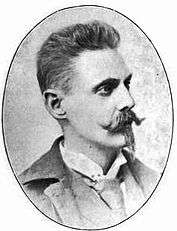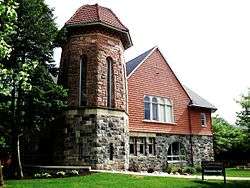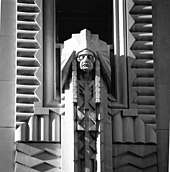Malcomson and Higginbotham
Malcomson and Higginbotham was an architectural firm started in the nineteenth century and based in Detroit, Michigan. A successor firm, Malcomson-Greimel and Associates, still exists in Rochester, Michigan as of 2010.
History
Architects William G. Malcomson and William E. Higginbotham formed a partnership in 1890.[1]
The firm was retained by the Detroit Board of Education in 1895,[1] and between 1895 and 1923 had designed over 75% of the school buildings in Detroit.[2] The firm remained in business under various names until the present.


William G. Malcomson
William George Malcomson was born in 1856 in Hamilton, Ontario.[3] He began his architectural career early, and in 1875 supervised the construction of the Henry Langley-designed Erie Street United Church in Ridgetown, Ontario.[4] In 1882, Malcomson married Jennie E. McKinlay of Ridgetown, Ontario; the couple had five children. William G. Malcomson died in 1937.[5]
William E. Higginbotham
William E. Higginbotham was born in 1858 in Detroit.[3] He was educated in the Detroit public schools, and at the age of 19 joined the architectural form of J. V. Smith.[1] He married Nettie M. Morphy in 1892; the couple had two children:[3] a daughter, Doris Higginbotham (born 26 February 1893, Detroit; died 3 July 1983, Lafayette, LA) and a son, Bruce Field Higginbotham (born 1895, Detroit; died 1939, Atlanta, GA). William E. Higginbotham died in 1922.[1]
Other principals and architects
- Malcomson and Higginbotham began as a partnership between William G. Malcomson and William E. Higginbotham.
- Around 1907, the firm changed its name to "Malcomson, Higginbotham and Clement" with the addition of Hugh B. Clement as a partner. Clement soon left, and the name reverted to "Malcomson and Higginbotam".
- Wirt C. Rowland joined the firm, though not as a partner, in 1912 and stayed until 1915 when he rejoined Albert Kahn.[6]
- C. William Palmer became a partner in 1920 and the firm became known as "Malcomson, Higginbotham and Palmer",[7] reverting again to "Malcomson and Higginbotham" upon Palmer's departure in 1924, despite Higginbotham's death in 1922.
- In 1925, Alexander L. Trout became a partner,[8] and the firm once more changed its name to "Malcomson and Higginbotham and Trout" until 1935, when Trout left.[9]
- The firm finally dropped Higginbotham's name after Malcomson's death in 1937 with the addition of Ralph R. Calder,[9] and Maurice E. Hammond, becoming "Malcomson, Calder, and Hammond"; they remained under that name until 1945,[9] when Ralph R. Calder resigned to establish his eponymous firm, which remains in business.
- In 1945, Homer A. Fowler became a partner, and the firm name was changed to "Malcomson, Fowler, and Hammond".[10] until 1958 at least.
- In the 1960s, the firm merged with that of Karl H. Greimel to become "Greimel, Malcomson and Hammond". Karl Greimel was the dean of Lawrence Technological University's School of Architecture from 1974 - 1991.[11]
- The firm was later known as "Greimel, Malcomson, and James".
- The firm changed its name to "Malcomson-Greimel and Associates", and still exists as of 2018.
List of structures designed by Malcomson and Higginbotham

- All buildings are located in Detroit, unless otherwise indicated.
- Our Lady of the Rosary Roman Catholic Church, 1883
- Hook and Ladder House No. 5-Detroit Fire Department Repair Shop, 1888
- Cass Avenue Methodist Episcopal Church, 1891 (addition)[12]
- Old Main (Wayne State University), 1895[13]
- Mackenzie House, 1895[14]
- George P. MacNichol House, Wyandotte, Michigan, 1896
- Verona Apartments, 1896
- James A. Garfield School, 1896
- Starkweather Hall (Eastern Michigan University), Ypsilanti, Michigan, 1896
- Ford-Bacon House, Wyandotte, Michigan, 1897
- Arthur M. Parker House, 1901
- Henry S. Frieze Building (University of Michigan), Ann Arbor, Michigan, 1905
- Henry Ford House, 1907
- Jefferson Intermediate School, 1922
- Nellie Leland School, 1918
- Cass Technical High School, 1922 (demolished, 2011)
- Flint Central High School, Flint, Michigan, 1923
- Ann Arbor Elementary School, Ann Arbor, Michigan, 1929
- Mosher-Jordan Hall (University of Michigan), Ann Arbor, Michigan, 1930
- University of Detroit Jesuit High School and Academy, 1931
- Mary Mayo Hall (Michigan State University), East Lansing, Michigan, 1931[15]
- Sarah Langdon Williams Hall (Michigan State University), East Lansing, Michigan, 1937
See also
References
- Detroit Board of Education (1922). The Detroit educational bulletin, Volume 18, Issues 1-2. p. 23.
- "An Honor and an Ornament: Public School Buildings in Michigan" (PDF). Michigan Department of History, Arts and Libraries. September 2003. Retrieved June 29, 2010.
- Mannausa & Weber (1907). The government of the city of Detroit and Wayne County, Michigan: 1701 to 1907, historical and biographical, illustrated. pp. 174–177.
- "Chatham-Kent". Architectural Conservancy of Ontario. Retrieved June 29, 2010.
- Detroit engineer, 2–3, Engineering Society of Detroit, 1937
- James W. Tottis (2008), The Guardian Building: cathedral of finance, Wayne State University Press, p. 14, ISBN 0-8143-3385-0
- "American Architect's Directory, 1956" (PDF). p. 416. Archived from the original (PDF) on March 31, 2012. Retrieved June 29, 2010.
- "Mosher-Jordan Halls". Bentley Historical Library. Archived from the original on August 19, 2010. Retrieved June 29, 2010.
- "American Architect's Directory, 1956" (PDF). p. 2. Archived from the original (PDF) on March 31, 2012. Retrieved June 29, 2010.
- Michigan Society of Architects (1953), Bulletin of the Michigan Society of Architects, 27, The Society
- "Karl Greimel, noted dean of architecture". Detroit News. April 26, 2000.
- Hill, Eric J. and John Gallagher (2002). AIA Detroit: The American Institute of Architects Guide to Detroit Architecture. Wayne State University Press. ISBN 0-8143-3120-3. P. 128.
- Hill and Gallagher, 2002, p. 142.
- Hill and Gallagher, 2002, p. 132.
- Federal Writers' Project (1949), Michigan. A guide to the Wolverine state, US History Publishers, pp. 340–341, ISBN 1-60354-021-0
Further reading
- Hill, Eric J. and John Gallagher (2002). AIA Detroit: The American Institute of Architects Guide to Detroit Architecture. Wayne State University Press. ISBN 0-8143-3120-3.

